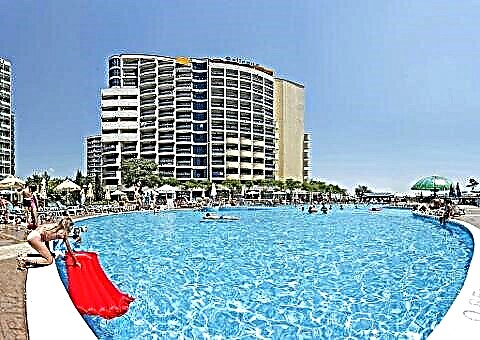Address: Russia, St. Petersburg, Pushkin, Tsarskoe Selo
Foundation date: 1717 year
Area: 107 hectares
Main attractions: The Great Catherine Palace, the Hermitage Pavilion, the Hermitage Pavilion, the Grotto Pavilion, the Cameron Gallery, the Admiralty, the Hall on the Island Pavilion, the Big Pond, the Chesme Column, the Marble Bridge, the Turkish Bath, the Girl with a Jug Fountain, pavilion "Turkish bath"
Coordinates: 59 ° 42'45.3 "N 30 ° 23'47.7" E
Content:
Tsarskoe Selo is known not only for its luxurious palace buildings and the memory of the youthful years of Alexander Pushkin. There are several unique parks here. The largest of them - Catherine's, appeared along with the construction of the royal palace, back in the time of Peter I. Walking along the picturesque alleys is a lot of pleasure.

Catherine Park from a bird's eye view
History of the park
In the 1720s, a new palace for Catherine I began to be erected in the former Swedish estate Sarskaya Manor. At the same time, it was decided to create a green park around it. For this, Peter I hired the Dutch masters Jan Roosen and Johann Focht.
In the forest, to the west of the palace, they set up a royal menagerie. The park was laid out on terraces, and the banks of the Big Pond were reinforced with piles. The elevated part began to be called the Upper Garden, and the one that was located near the pond, the Lower.
Straight alleys, gazebos and bosquets appeared in the park. Along the paths there were sculptures that were acquired by Tsar Peter I. From the south, the park was bordered by the Fish Canal, and behind it were trees, which in those days were called the "wild grove".

View of the Catherine Palace
In the middle of the 18th century, the territory was expanded. Several artificial reservoirs were created on canals and streams. During the reign of Elizabeth Petrovna, Tsarskoe Selo turned into a country residence, where the empress lived during the warm months. The palace was rebuilt, and the park was expanded to the Lower Ponds.
Gradually, the territory from the south, west and east of the Big Pond turned into a magnificent landscape park. Perennial trees from the gardens of St. Petersburg were transplanted here, as well as ornamental shrubs and young trees that were brought from abroad. New pavilions, galleries and bridges were built in the park.

View of the Upper Bath
The park ensemble received a lot of damage during the years of the fascist occupation. While German soldiers were in charge of Tsarskoe Selo, a quarter of all plantations were destroyed - about 3,000 trees. The restoration of the park began during the war years, and in the summer of 1945 it was opened to visitors. Today the unique park is included in the list of UNESCO World Heritage Sites.
Regular park
The old part of the Catherine Park was planned in the best traditions of French park art. While walking through the Regular Park, you can see the old pavilions.

Cameronova Gallery
The most unusual of them, the Hermitage, is located behind the Fish Canal. It was built in the 1740s according to the project of Mikhail Grigorievich Zemtsov. The two-story baroque building is very similar to the Great Catherine Palace. It was used for receiving foreign guests.
The empress loved the intimate atmosphere, so the servants in the Hermitage did not bring food to the table. There was a special mechanism in the building, thanks to which the treats were lifted up - to the hall where the queen and her guests dined. Nowadays, tourists can inspect the interior, admire the intricate stucco molding and richly decorated ceremonial tables.

Cold bath with Agate rooms
On the bank of the rectangular Mirror Pond, there is an elegant pavilion "Upper Bath". It is difficult to recognize the royal bath in a one-story classical building. However, until the end of the 19th century, there was a bath, a steam room and an octagonal relaxation room. Today exhibitions are held in the pavilion. Nearby is the Lower Bath - a bathhouse for courtiers, built in the 70s of the 18th century.
The Grotto pavilion, which is located on the northern bank of the Big Pond, is very beautiful. Today, temporary exhibitions are organized in the azure-white building.

Pavilion "Grotto"
The red-brick Hermitage Kitchen stands out among other pavilions. It was built in the tradition of English Gothic, but restoration work has not yet been completed here.
For more than two centuries, smooth alleys and paths have been decorated with park sculptures made by masters of the Venetian school at the beginning of the 18th century. They were brought here from the Summer Garden of St. Petersburg. Today, the oldest sculptures are installed in the Grotto pavilion, on the Main Alley and near the entrances to the Great Catherine Palace.

Pavilion "Hermitage"
According to the idea of Peter I, the statues of mythological characters were supposed to represent the military victories of Russia. However, already under his daughter Elizabeth Petrovna, the sculptures of Andromeda, Perseus, Hercules and Mars turned into ordinary park decorations.
Landscape park
The loosely planned English Garden appeared in Tsarskoe Selo in the second half of the 18th century. It was created thanks to the architect V.I. Neyelov and the landscape gardeners I. Bush and T. Ilyin. Walking along this part of the Catherine Park, you can feel the fragrant smell of conifers, enjoy the blooming of wild rose, lilacs and see agile squirrels.

Marble Bridge
To the east of the Big Pond rises the Admiralty. This is the name of a complex of three pavilions built of red brick. Previously, the royal flotilla was located here - an original collection of sailing and rowing ships that came to Russia from different countries of the world. Unfortunately, it has not survived to this day.
In the middle of the Big Pond is the picturesque Hall on the Island pavilion. The picturesque building was used for the recreation of guests who went boating. Today it hosts concerts and celebrations.

Pavilion "Milos Bath"
To the south of the Great Catherine Palace there is an unusual architectural monument - the Granite Terrace. It was built in the early 19th century from pink and gray granite and is decorated with statues. Above opens a wonderful view of the surface of the pond.
Tourists love to come to the romantic monument-fountain "Girl with a Jug". This is the only sculpture specially made for the Catherine Park. The bronze figure appeared in 1816. Its author, the talented sculptor Pavel Petrovich Sokolov, used the plot of the famous fable about a milkmaid who broke a jug. Visitors see a copy, and the original of the old fountain is kept in the museum's funds.

Granite terrace
Three park monuments are dedicated to the victory of Russia in the Russian-Turkish wars. These are the Kagul obelisk, the Morey and Chesme columns. In the southeast of the park, there is a cast-iron gate with twin columns, 5.7 m high. They were cast in 1817 by the sculptor Vasily Petrovich Stasov and are dedicated to the victory of the Russian army in the Patriotic War of 1812. Above in French are the words of Alexander I "To my dear colleagues."
In the southern part of the park there is an openwork Gothic gate. They were made of cast iron in the 70s of the 18th century. The craftsmen used an illustration from an album of architectural monuments of England, which came to Russia in the 1760s.

Fountain "Girl with a jug"
On the border of the park, by the road that leads towards Gatchina, there is the Oryol Gate. Their story is very interesting. The representative gate was erected by order of Catherine II and became a lifetime monument to her favorite Grigory Orlov. So the empress noted the merits of the count, who in 1771 led the fight against the plague in Moscow and managed to save the city from a terrible epidemic.
Useful information for visitors
One of the most beautiful monuments of landscape art is part of the museum-reserve. It covers an area of 107 hectares. A large area is fenced in and is open any day except Tuesday.From the end of October to the end of April, tourists are allowed into the park from 9:00 to 19:00, from May to July - from 7:00 to 23:00, in August - from 7:00 to 22:00, and in September from 7 : 00 to 21:00.

Chesme column
In winter and off-season, admission is free. From May to October they take 120 rubles from adults, 60 rubles from students and 30 rubles from pensioners. Visitors under the age of 18 and those who bought a ticket to the Great Catherine Palace are admitted to the park free of charge.
The administration offers an unusual tour of the park in an electric car. Tourists are shown the main pavilions and attractions. The trip is 45 minutes long and costs 250 rubles. Tickets for excursions are sold at the box office, which is located near the Admiralty.
You can ride on horseback in the Catherine Park. An hour of horseback riding will cost 4000 rubles. They ride around the territory in an eight-seater horse-drawn carriage, and on the surface of the Big Pond, tourists are taken on gondolas.

Admiralty
How to get there
Catherine Park is located in the city of Pushkin, 25 km south of St. Petersburg. It is convenient to get here by electric trains. Take a train at Vitebsk or Baltiysky railway stations and get to Tsarskoe Selo station. Buses and minibuses run from the railway to the park. Many tourists come to Pushkin by regular buses that run from the metro stations "Zvezdnaya", "Kupchino" and "Moskovskaya".











